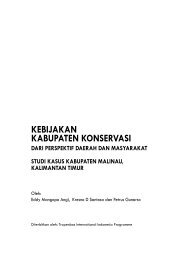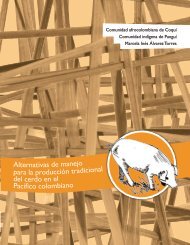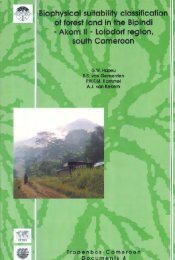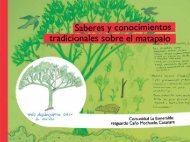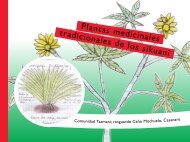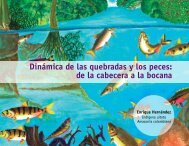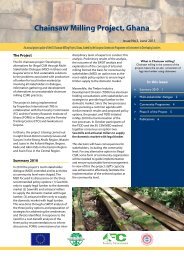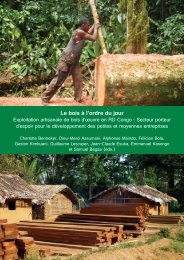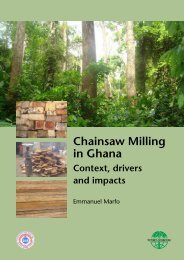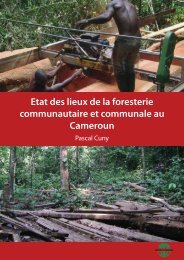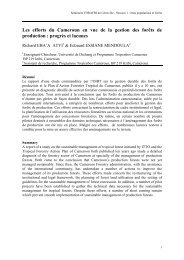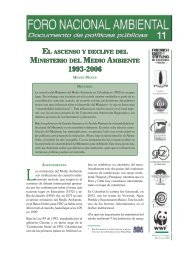Download the publication - Tropenbos International
Download the publication - Tropenbos International
Download the publication - Tropenbos International
You also want an ePaper? Increase the reach of your titles
YUMPU automatically turns print PDFs into web optimized ePapers that Google loves.
Plant diversity in a Central African rain forest: Implications for biodiversity conservation in Cameroon<br />
group which is mainly found inland. In <strong>the</strong> Campo-Ma’an area, <strong>the</strong> distribution of<br />
Rinorea species showed that Rinorea microglossa and Rinorea sp. nov1. were<br />
restricted to <strong>the</strong> coastal area between Kribi and Campo, while o<strong>the</strong>r species were<br />
mostly found in <strong>the</strong> lowland evergreen forest rich in Caesalpinioideae.<br />
The Atlantic Biafran forest rich in Caesalpinoideae is often considered to represent<br />
<strong>the</strong> real climax forest vegetation while <strong>the</strong> Atlantic littoral forest type is regarded as<br />
<strong>the</strong> result of its degradation (Letouzey, 1983). In <strong>the</strong> Campo-Ma’an area, <strong>the</strong><br />
distributions of Caesalps show a high concentration of bio-indicator species in <strong>the</strong><br />
lowland evergreen forest rich in Caesalpinioideae, and in <strong>the</strong> submontane forest.<br />
There is a decrease in <strong>the</strong> number of species in <strong>the</strong> coastal forest rich in Sacoglottis<br />
gabonensis, and particularly in <strong>the</strong> mixed evergreen and semi-deciduous forest<br />
where semi-deciduous and secondary forest species became increasingly important.<br />
Fur<strong>the</strong>rmore, <strong>the</strong>re was a high concentration of bio-indicator species in <strong>the</strong> park and<br />
in <strong>the</strong> Kribi-Campo-Mvini area on <strong>the</strong> higher slopes of <strong>the</strong> lowland forests and along<br />
riverbanks. This pattern supports <strong>the</strong> view of many authors who argued that during<br />
glacial times, patches of forests were restricted to higher altitude lowland forests,<br />
especially along <strong>the</strong> upper slopes of hills near <strong>the</strong> top (F.J. Breteler pers. comm.) or<br />
along riverbanks where <strong>the</strong>re was enough humidity necessary for <strong>the</strong>ir survival.<br />
Therefore, we can hypo<strong>the</strong>size that past glacial forest expansion started in <strong>the</strong><br />
Campo-Ma’an area from isolated patches of mid and higher elevation evergreen rain<br />
forest rich in Caesalpinioideae, located within <strong>the</strong> mountainous range that extents<br />
from Ebianemeyong to <strong>the</strong> Akom II. Moreover, <strong>the</strong> Campo-Ma’an area has a dense<br />
hydrographical pattern with many rivers and streams that may have played an<br />
important role during <strong>the</strong> dry-out periods, as <strong>the</strong>y supplied humid conditions that<br />
may have allowed <strong>the</strong> survival of some forest types. This is illustrated today with <strong>the</strong><br />
occurrence of indicator species such as Aphanocalyx ledermannii, Begonia<br />
anisosepala, B. zenkeriana and Gilbertiodendron demonstrans, which are often<br />
found in marshy places and along stream and river banks in <strong>the</strong> coastal forest and on<br />
Dipikar Island. At <strong>the</strong> same time it may be hypo<strong>the</strong>sized that <strong>the</strong> persistence of<br />
Caesalpinioideae forests in this so-called western part of <strong>the</strong> south Cameroon forest<br />
refuge prevented Aucoumea klaineana to extend its distribution fur<strong>the</strong>r northwards.<br />
As discussed in Chapters 2 & 6, <strong>the</strong> lowland evergreen forest rich in<br />
Caesalpinioideae with Calpocalyx heitzii and Sacoglottis gabonensis is only known<br />
from <strong>the</strong> Campo area. This forest type, as well as <strong>the</strong> coastal forest and <strong>the</strong> mixed<br />
evergreen and semi-deciduous forest are characterised by a high number of fully<br />
grown and developed secondary forest species. Letouzey (1983) mentioned that<br />
Alstonia boonei, Calpocalyx heitzii, Lophira alata, Pycnanthus angolensis,<br />
Sacoglottis gabonensis and Terminalia superba are light demanding species with an<br />
invasive habit that frequently colonise forest gaps. He fur<strong>the</strong>r argued that forest<br />
types rich in such species, will have difficulties to expand into <strong>the</strong> Caesalpinioideae<br />
forest, because <strong>the</strong>ir regeneration will be hampered since <strong>the</strong>ir seedlings and<br />
saplings will not survive in <strong>the</strong> understorey of such forest communities. The present<br />
mosaic pattern of some forest types, characterised by a mixture of evergreen, semideciduous<br />
and secondary forest species, is probably <strong>the</strong> consequence of long-term<br />
disturbances, which may have affected <strong>the</strong>se areas since <strong>the</strong> glacial times,<br />
particularly <strong>the</strong> major disturbance which culminated about 2500 BP (Maley, 2002).<br />
However, it should be noted that recent and past human activities have also<br />
76



